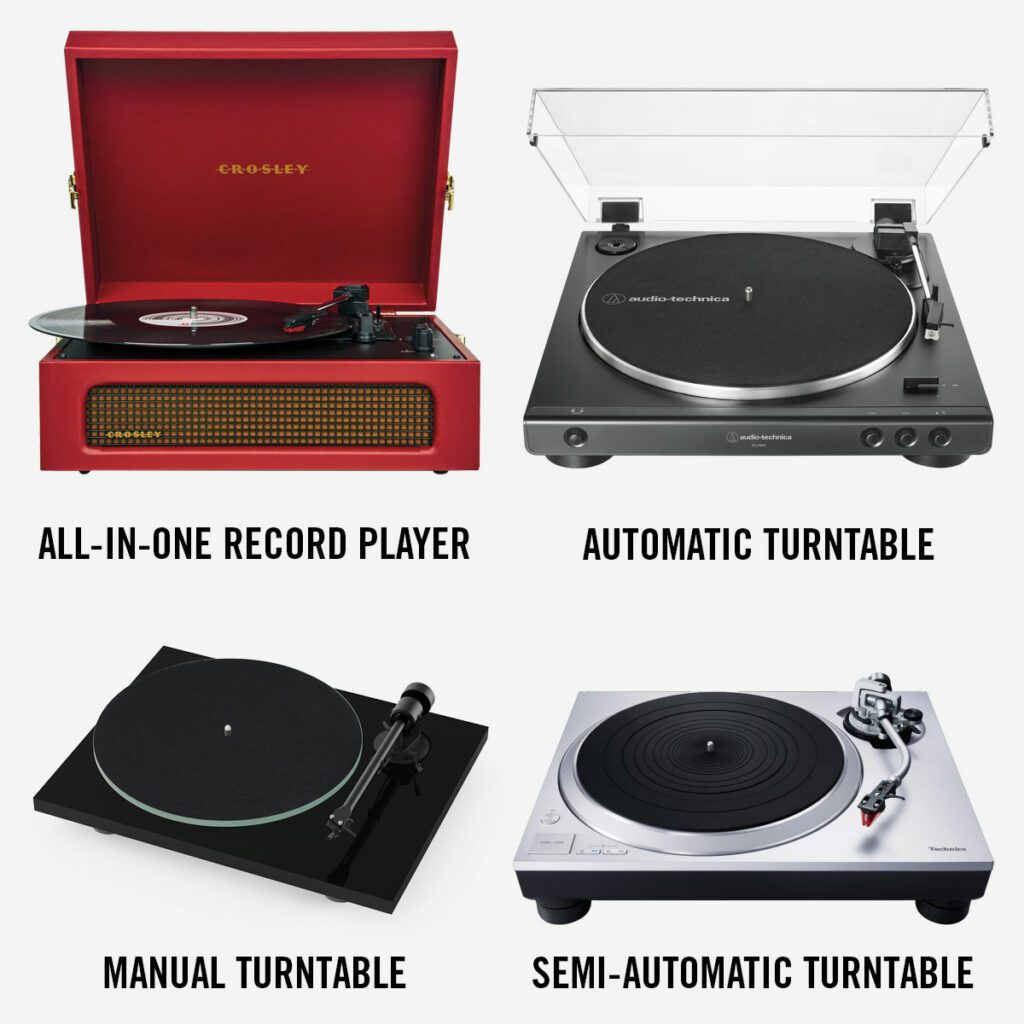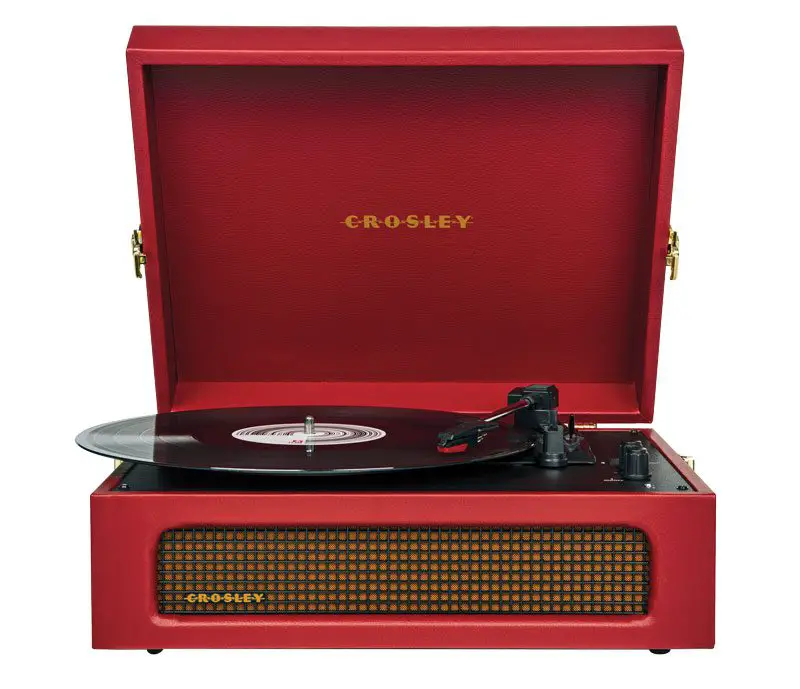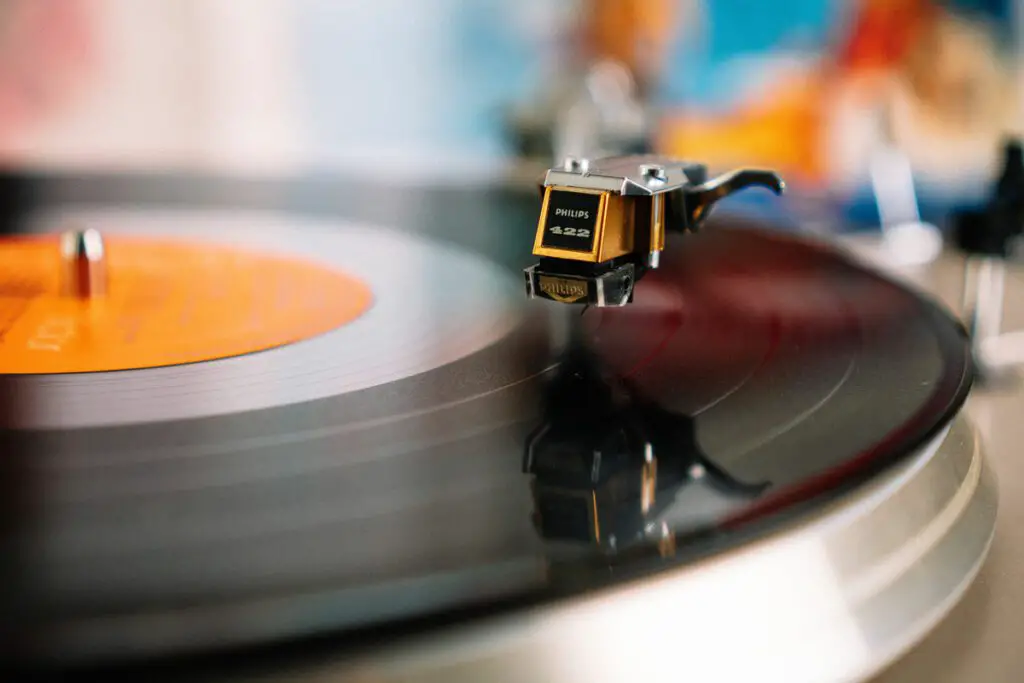Leaving the Record Player Arm Up to Play the Record Over Again
And then you've got your first tape thespian and y'all're prepare to outset spinning records. Congratulations! You're nigh to experience the most rewarding manner to enjoy music.
But wait… How do you use a record histrion? (or turntable for that matter).
Vinyl enthusiasts can often assume everyone knows how to apply a turntable, but do they? We live in a digital globe, and while vinyl is growing in popularity, it can be intimating if you've never used one before.
Having recently allowed my brother admission to my tape collection while babysitting my kids, I was inspired to write a simple-to-understand guide.
Sure, anyone can use a turntable, simply if yous want to avoid damaging your records, there's a right and a wrong fashion to operate your deck.
First Up: What Type of Record Player or Turntable Do Y'all Own?
Devices for playing vinyl records come in many forms, shapes and sizes, and while the core components from one to another are very similar, the operation of your deck will vary slightly from ane type of record role player to another.
There are four primary types of tape thespian we'll delve into:
- All-in-One Record Player with Built-in Speakers
- Automated Turntables
- Manual Turntables
- Semi-Automated Turntables

All of these designs accept a few parts in common:
The Plinth – The base of operations of your turntable/tape thespian.
The Platter – This is the turntable element or your record player that sits on height of the principal plinth. Put simply; information technology's the part that rotates your record, and hence why the terms record thespian and turntable are often interchanged.
The Tone Arm – Your tonearm pivots from the outside edge of the record toward the heart. At the cease of a tonearm is your cartridge, which has a needle (better known as the stylus) responsible for tracking your record's groove.

How to Utilise a Tape Thespian with Built-in Speakers
If you own a record histrion with built-in speakers, such as the all-in-ane suitcase-manner models from manufacturers like Crosley, Steepletone, and Victrola, so you can become started spinning records right out of the box.
These turntables are designed to be portable, all-in-one units for beginners. In that location is a lot of snobbery in the vinyl community about these brands, as they do non offer the aforementioned level of audiophile, HiFi experience equally more expensive turntable models.
However, if this gets yous started on your vinyl journey, I say crack on!

Your all-in-one record player likely features a set of built-in speakers, so there is no requirement to plug the unit into a carve up receiver, amplifier, or powered speakers.
The congenital-in speakers are enough to go you started, only they can often audio quite thin. You will notice a meaning uplift in quality by connecting the tape player to external speakers if you lot can.
Some units feature RCA output connectors at the back, which enable you lot to plug into the "AUX" input of a receiver or speakers for significantly better sound quality.

Increasingly, these units are often equipped with Bluetooth connectivity, which is a user-friendly fashion to connect to your existing home amusement systems or even a smart speaker.
Playing a Vinyl Record: Step-past-Footstep Guide:
Time needed:5 minutes.
Playing a vinyl record is easy when you know how. Below is our easy to follow guide on how to play a vinyl record:
- Gently pull the record from its sleeve
Exist careful non to touch on the tape grooves. Ever hold your records by the edges and characterization so as non to muddy up the tape with oils from your fingertips. - Identify the record
Place the tape on the plater so the spindle goes through the eye hole of the tape. Each side is labeled A & B (possibly C & D as well if it's a double LP). - Adjust the speed
Check the speed of your record. Most 12 inch LPs are 33 ane/3 RPM and vii-inch singles are 45 RPM.
However, there are exceptions, and then check the center label where you'll usually discover the speed indicated. If the speed isn't specified, then presume 33 or an LP and 45 for a single.
Near record players and turntables have a simple switch somewhere on the plinth to adjust speed.
- Check the cue lever
If your tape player has a cue lever for raising and lowering the tonearm, apply it!
Don't effort to raise and lower the tonearm on your records by manus if you don't have to – you'll undoubtedly risk scratching a tape somewhen.
- Position the tonearm
With the cue lever set to the up position, slowly pivot the tonearm over to the edge of your record.
Using your eye, look down to ensure the stylus (or needle if you prefer) is hovering simply inside the disc.
Y'all don't want to aim too close to the edge, or the stylus will fail to catch the run-in groove and sideslip off the side.
- Lower the tonearm
Y'all can at present utilise the cue lever to lower your stylus with the record spinning. The stylus will take hold of the groove and music will showtime to play!
Congratulations. That was easy and the procedure is really interactive; information technology's all part of the feel and joy of music on vinyl.
How to Skip Tracks on a Vinyl Record
Unlike a CD or a streaming platform, there is no 'skip runway' push for vinyl records. This 'inconvenience' — if yous can put it that way — is part of what makes vinyl the best way to experience the anthology every bit an fine art form.
By and large, it's better to lower the stylus at the offset of your record and let information technology play from start to stop. This way, we avoid potentially damaging the record past continuously raising and lowering the stylus across the record surface.
Saying this, you can select a track using your cue lever. Here's how:
Look closely at the record; you'll observe some thin darker sections across the surface. These spaces are the silence between tracks. Keeping your cue arm in the raised position, you tin can hover the stylus over these spaces and lower the tonearm, and if you've managed to line things up successfully, the record volition start from this point.
If your record role player does not have a cue lever, I don't recommend attempting this at all equally you'll never be able to keep a steady mitt when lowering the tonearm by hand.

Using an Automated Turntable
Automatic turntables work differently from near all-in-one tape players and transmission turntables. They offer many conveniences to music lovers who adopt the ease of use.
With the push button of a push button, a fully automatic turntable volition raise the tonearm and lower it precisely at the start of your record. Equally, the arm will lift automatically at the end of each side and return to where it started.
So if you happen to fall asleep before the record finish, an automatic turntable prevents the stylus from rocking endlessly dorsum and forth at the stop of one side. This space (by the style) is what we call the run-out groove. It creates a continuous loop for the stylus, preventing it from running into the label.
Automatic turntables offering much in the manner of convenience, merely there are compromises in terms of mechanical noise and interference. For instance, because the plinth of an automatic turntable needs to house mechanical devices, the design can't be solid, leaving it more open to resonance issues.
From an operation perspective, you lot can oft move the tonearm yourself, only this typically starts the platter spinning, and in the absence of a manual cue lever, it'southward down to your steady (or not so steady) mitt to cue up and skip tracks if that'south what you lot'd like to practise.
Imagine trying to find the silence between tracks and lowering it in place while the record is spinning – risky stuff! My get-go turntable was a Marrantz automated deck that operated in this mode, and I definitely caused some damage trying to cue upwardly tracks.
Setting Up Your Automatic Turntable – Step-By-Step
Unlike all-in-one tape players, automatic turntables normally need external amplifiers and speakers.
Step One: Identify if your deck has a congenital-in phono preamp. Many automatic decks come up with a built-in phono stage, just if it doesn't you'll need to cheque if your receiver/amplifier has an input labeled "phono", which, if accompanied past a footing input, should bespeak you lot're looking at a built-in amplifier-side phono preamp.
Failing this, yous'll need to buy an external phono preamp to sit betwixt your turntable and the amplifier/powered speakers.
Footstep Two:Make sure your turntable is placed on a split up surface from your speakers if you can, as vibrations (particularly bass frequencies) from your speakers can cause the tape to skip or simply degrade the audio performance.
Step Three: Plug your turntable into the receiver or powered speakers. If your deck has a born phono phase, you can take the RCA cables, choice and AUX input on your amplifier, receiver, or powered speakers, and you're good to go.
If you're dealing with an external phono preamp, so you'll start need to run RCA cables with a ground cable and connect it to the phono preamp. Failing to connect the basis cable can result in significant noise in the form of a buzzing sound.
After this, you can treat the signal from your external preamp in the same way equally our congenital-in phono instance, and simply run RCA cables to an AUX input.
What Happens If I Don't Use a Phono Preamp?
Failing to utilise a phono preamp, either built-in or external, will result in a very sparse, quiet sound.
In very uncomplicated terms, this is because records are cut with the frequencies adjusted and at a very quiet level to brand the playback mechanism physically possible and practical.
To make the sound picked upward by your stylus sound normal over again, the betoken must be processed in a specific manner by a phono preamp.
I've heavily simplified the clarification of what a preamp does for the purpose of this article, merely if you lot'd like to empathise more, check out our guide to phono preamps.
How to Use a Manual Turntable
Fully manual turntables typically occupy a higher-terminate portion of the market compared to all-in-i tape players and automatic turntables. Notwithstanding, there are many very affordable models out there.
In this instance, y'all're in the driving seat, much like most all-in-i tape players with a cue arm, only the components are unremarkably much higher quality.
Some manual turntables, such every bit my Technics SL1500, offer semi-automatic features like an motorcar lift at the end of each side. These attempt to bring some convenience features to a higher-end manual turntable.
Manual turntables let more user upgrades than near all-in-one or automated units, which often have fixed cartridges that tin't exist replaced or swapped. Depending on which model yous have, it'south possible every core component from the cartridge to the platter, and fifty-fifty the whole tonearm could be upgraded.
The Bottom Line
In reality, the process of how to use a record thespian is very similar from model to model, so no thing what your budget is for getting started with vinyl records, you lot tin can enjoy the therapeutic process of spinning a record.
Welcome to the best way to experience music. This level of engagement and feel from a music format just can't exist replicated in the digital historic period. Withal you arrived hither, we promise yous enjoy your analog journey.
Source: https://www.yoursoundmatters.com/how-to-use-a-record-player-turntable/
0 Response to "Leaving the Record Player Arm Up to Play the Record Over Again"
Post a Comment